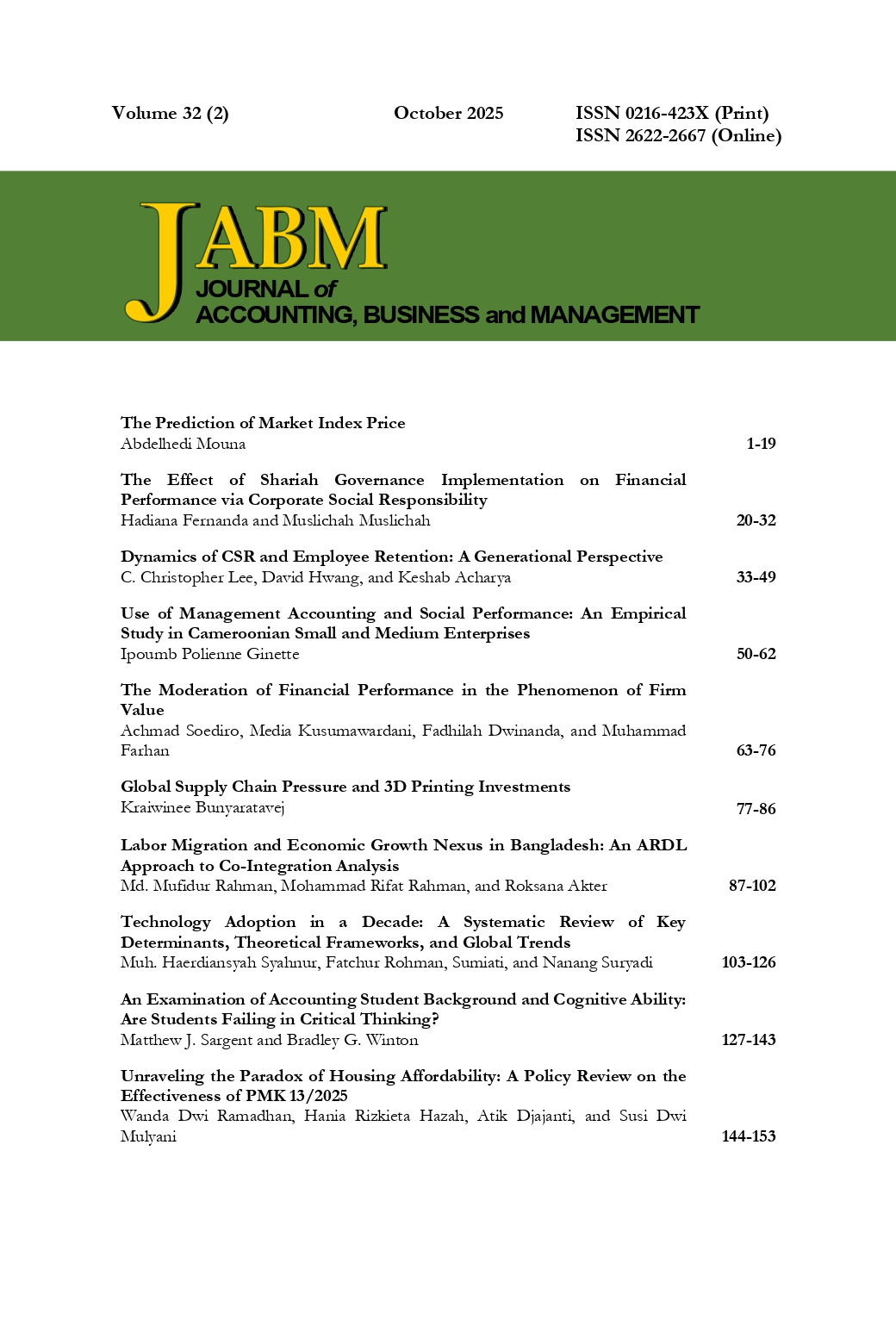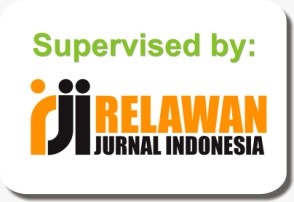Technology Adoption in a Decade:
A Systematic Review of Key Determinants, Theoretical Frameworks, and Global Trends
Abstract
This study addresses the increasing complexity of understanding factors influencing technology adoption, particularly in developing countries where emerging technologies evolve rapidly. The research aims to identify and analyze dominant trends, theoretical frameworks, variables, and contextual factors shaping technology adoption over the past decade. Using a systematic literature review (SLR) of 57 Scopus-indexed articles published between 2015 and 2025, data were processed through the PRISMA protocol and analyzed using VOSviewer software and meta-synthesis techniques. The findings reveal that perceived ease of use and perceived usefulness remain the most prevalent determinants, while new psychological, social, and cultural dimensions—such as trust, autonomy, technophobia, and social influence—are gaining scholarly attention. Research from developing economies, notably India, Bangladesh, and Indonesia, highlights context-specific challenges and the transformative role of technology in digital ecosystems. The study contributes by proposing an integrative framework synthesizing TAM, TPB, UTAUT, and S-O-R models, offering a comprehensive foundation for future research, policymaking, and practical innovation in technology adoption.
Downloads
References
Ajzen, I. (1991). The theory of planned behavior. *Organizational Behavior & Human Decision Processes, 50(2),* 179-211. Doi: 10.1016/0749-5978(91)90020-T.
Ajzen, I. (2011). The theory of planned behaviour: Reactions and reflections. *Psychology & Health, 26(9),* 1113-1127. Doi: 10.1080/08870446.2011.613995.
Ajzen, I. (2012). Martin Fishbein’s legacy: The reasoned action approach. *The Annals of the American Academy of Political & Social Science, 640(1),* 11–27. Doi: 10.1177/0002716211423363.
Al-Mamary, Y. H., & Abubakar, A. A. (2025). Empowering ChatGPT adoption in higher education: A comprehensive analysis of university students’ intention to adopt artificial intelligence using self-determination and technology-to-performance chain theories. *The Internet & Higher Education, 66*, 101015. https://doi.org/10.1016/j.iheduc.2025.101015.
Beck, L., & Ajzen, I. (1991). Predicting dishonest actions using the theory of planned behavior. *Journal of research in personality, 25(3),* 285-301. https://doi.org/10.1016/0092-6566(91)90021-H.
Bergman, E. M. L. (2012). Finding citations to social work literature: The relative benefits of using web of science, scopus, or google scholar. *The Journal of Academic Librarianship, 38(6),* 370-379. https://doi.org/10.1016/j.acalib.2012.08.002.
Buba, A. K., Ibrahim, O., & Shehzad, H. M. F. (2022). Behavioral intention model for green information technology adoption in Nigerian manufacturing industries. *Aslib Journal of Information Management, 74(1),* 158-180. https://doi.org/10.1108/ajim-05-2021-0128.
Cecil, J., Kleine, A. -K., Lermer, E., & Gaube, S. (2025). Mental health practitioners’ perceptions and adoption intentions of AI-enabled technologies: An international mixed-methods study. *BMC Health Services Research, 25(1),* 556. https://doi.org/10.1186/s12913-025-12715-8.
Creswell, J. W., & Clark, V. L. P. (2017). *Designing and conducting mixed methods research* (3rd ed.). Sage publications.
Daruwala, N. A. (2025). Behavioural intention and smart home technology adoption: The role of technophobia and psychological needs across cultures and genders. *International Journal of Technology & Human Interaction, 21(1),* 1-24. https://doi.org/10.4018/ijthi.372059.
Davis, F. D. (1989). Perceived usefulness, perceived ease of use, and user acceptance of information technology. *MIS Quarterly: Management Information Systems, 13(3),* 319-339. https://doi.org/10.2307/249008.
Dhiman, N., & Jamwal, M. (2023). Tourists’ post-adoption continuance intentions of chatbots: integrating task-technology fit model and expectation-confirmation theory. *Foresight, 25(2),* 209-224. https://doi.org/10.1108/fs-10-2021-0207.
Hofstede, G. J., & Liu, C. (2020). To stay or not to stay? Artificial sociality in GRASP world. In H. Verhagen, M. Borit, G. Bravo, & N. Wijermans (Eds.), _Advances in social simulation: Looking in the mirror_ (pp. 217-233). Switzerland: Springer Nature Link. https://doi.org/10.1007/978-3-030-34127-5_20.
Hu, Z., Ding, S., Li, S., Chen, L., & Yang, S. (2019). Adoption intention of fintech services for bank users: An empirical examination with an extended technology acceptance model. _Symmetry_, _11_(3), 340. https://doi.org/10.3390/sym11030340.
Huang, M. H., & Rust, R. T. (2021). A strategic framework for artificial intelligence in marketing. _Journal of the Academy of Marketing Science_, _49_, 30-50. https://doi.org/10.1007/s11747-020-00749-9.
Iskender, A., Sirakaya-Turk, E., Cardenas, D., & Hikmet, N. (2024). Restaurant patrons' intentions toward QR code menus in the U.S. during COVID-19: Acceptance of technology adoption model (ATAM). _Journal of Foodservice Business Research_, _27_(5), 497-522. https://doi.org/10.1080/15378020.2022.2133518.
Issock, P.B., Jacobs, A., & Koopman, A. (2024). Immersive escapes: examining the impact of personality traits, perceived enjoyment, flow and trust on virtual reality technology adoption intentions in an emerging market. _Cagent Business & Management_, _11_(1), 2364835. Doi: 10.1080/23311975.2024.2364835.
Kavaarpuo, G., Tiwari, P., & Martel, A. (2025). Beyond intentions: Transaction uncertainties and developers' adoption of nonconventional housebuilding technologies. _Habitat International_, _156_(1), 103295. https://doi.org/10.1016/j.habitatint.2025.103295.
Khan, A. U., Jan, S. U., Khan, M. N., Aziz, F., Sohu, J. M., Ali, J., Khan, M., & Chohan, S. R. (2024). Based on the S-O-R theory adoption intention of blockchain technology in libraries: A two-stage analysis SEM-PLS and ANN. _Library Hi Tech_, _42_(6), 1599-1621. https://doi.org/10.1108/lht-03-2024-0128.
Kim, K.-J., & Shin, D. -H. (2015). An acceptance model for smart watches: Implications for the adoption of future wearable technology. _Internet Research_, _25_(4), 527-541. https://doi.org/10.1108/IntR-05-2014-0126.
Kuberkar, S., & Singhal, T. K. (2021). Factors influencing the adoption intention of blockchain and internet-of-things technologies for sustainable blood bank management. _International Journal of Healthcare Information Systems & Informatics_, _16_(4), 11-21. https://doi.org/10.4018/ijhisi.20211001.oa15.
Kumar, R., & Sharma, R. (2025). AI-driven dynamic trust management and blockchain-based security in industrial IoT. _Computers & Electrical Engineering_, _123_, 110213. https://doi.org/10.1016/j.compeleceng.2025.110213.
Litman, T., & Burwell, D. (2006). Issues in sustainable transportation. _International Journal of Global Environmental Issues_, _6_(4), 331-347. Doi: 10.1504/IJGENVI.2006.010889.
Liu, C. -H., Dong, T. -P., & Vu, H. T. (2023). Transformed virtual concepts into reality: Linkage the viewpoint of entrepreneurial passion, technology adoption propensity and advantage to usage intention. _Journal of Retailing & Consumer Services_, _75_, 103452. https://doi.org/10.1016/j.jretconser.2023.103452.
Martins, J., Goncalves, R., & Branco, F. (2024). A bibliometric analysis and visualization of e-learning adoption using VOSviewer. _Universal Access in the Information Society_, _23_(3), 1177-1191. https://doi.org/10.1007/s10209-022-00953-0.
McKnight, D. H., Liu, P., & Pentland, B. T. (2020). Trust change in information technology products. _Journal of Management Information Systems_, _37_(4), 1015-1046. https://doi.org/10.1080/07421222.2020.1831772
Moher, D., Liberati, A., Tetzlaff, J., & Altman, D. G. (2009). Preferred reporting items for systematic reviews and meta-analyses: the PRISMA statement. BMJ, 339 (b2535). https://doi.org/10.1136/bmj.b2535.
Obal, M. (2017). What drives post-adoption usage? Investigating the negative and positive antecedents of disruptive technology continuous adoption intentions. Industrial Marketing Management, 63, 42-52. https://doi.org/10.1016/j.indmarman.2017.01.003.
Oliveira, T., Thomas, M., Baptista, G., & Campos, F. (2016). Mobile payment: Understanding the determinants of customer adoption and intention to recommend the technology. Computers in Human Behavior, 61, 404-414. https://doi.org/10.1016/j.chb.2016.03.030.
Onwuegbuzie, A. J., Slate, J. R., Leech, N. L., & Collins, K. M. T. (2007). Conducting mixed analyses: A general typology. International Journal of Multiple Research Approaches, 1(1), 4-17. Doi: 10.5172/mra.455.1.1.4.
Panic, N., Leoncini, E., de Belvis, G., Ricciardi, W., & Boccia, S. (2013). Evaluation of the endorsement of the preferred reporting items for systematic reviews and meta-analysis (PRISMA) statement on the quality of published systematic review and meta-analyses. PloS One, 8(12), e83138. Doi: 10.1371/journal.pone.0083138.
Payal, R., Sharma, N., & Dwivedi, Y. K. (2024). Unlocking the impact of brand engagement in the metaverse on real-world purchase intentions: Analyzing pre-adoption behavior in a futuristic technology platform. Electronic Commerce Research & Applications, 65, 101381. https://doi.org/10.1016/j.elerap.2024.101381.
Putro, A. K., & Takahashi, Y. (2024). Entrepreneurs’ creativity, information technology adoption, and continuance intention: Mediation effects of perceived usefulness and ease of use and the moderation effect of entrepreneurial orientation. Heliyon, 10(3), e25479. https://doi.org/10.1016/j.heliyon.2024.e25479.
Ramlawati, R., Bahari, A. F., & Syahnur, M. H. (2022). Company’s performance as measured by the application of big data analysis capabilities for customers. Jurnal Minak: Management Ide & Inspirats, 9(1), 109-126. Doi: 10.24252/minds.v9i1.26189.
Rocha, T., & Barroso, J. (2022, February). Accessibility: A systematic literature review. In A. Abraham, A. M. Madureira, A. Kaklauskas, N. Gandhi, A. Bajai, A. K. Muda, D. Kriksciuniene, & J. C. Ferreira (Eds.), Innovations in bio-inspired computing and applications: Proceedings of the 12th International Conference on Innovations in Bio-Inspired Computing and Applications (IBICA 2021) Held During December 16–18, 2021 (Vol. 419, pp. 447). Springer Nature.
Rogers, E. M., Singhal, A., & Quinlan, M. M. (2014). Diffusion of innovations. In D. W. Stacks & M. B. Salwen (Eds.), An integrated approach to communication theory and research (pp. 432-448). Routledge.
Sarker, T., Roy, R., Yeasmin, S., Rabbany, Md. G., & Asaduzzaman, M. (2025). Technology adoption intention and sustainable entrepreneurship ability of rural women in Bangladesh. Business Strategy & Development, 8(1), e70067. https://doi.org/10.1002/bsd2.70067.
Shah, J. L., Bhat, H. F., & Khan, A. I. (2021). Integration of cloud and IoT for smart e-healthcare. In A. J. Dhatterwal, H. F. Bhat, & A. I. Khan (Eds.), Healthcare paradigms in the internet of things ecosystem (pp. 101-136). Academic Press.
Shah, S. A. H., & Hisashi, K. (2025). Users’ adoption intentions of ridesharing services in Lahore, Pakistan: An empirical examination with an extended technology acceptance model. Research in Transportation Business & Management, 60, 101335. https://doi.org/10.1016/j.rtbm.2025.101335.
Siddaway, A. P., Wood, A. M., & Hedges, L. V. (2019). How to do a systematic review: A best practice guide for conducting and reporting narrative reviews, metaanalyses, and meta-syntheses. Annual Review of Psychology, 70(1), 747-770. Doi: 10.1146/annurev-psych-010418-102803.
Ter Huurne, M., Ronteltap, A., Corten, R., & Buskens, V. (2017). Antecedents of trust in the sharing economy: A systematic review. Journal of Consumer Behaviour, 16(6), 485-498.
Tummalapenta, S. R., Pasupuleti, R. S., Chebolu, R. M., Banala, T. V., & Thiyyagura, D. (2024). Factors driving chatGPT continuance intention among higher education students: Integrating motivation, social dynamics, and technology adoption. Journal of Computers in Education. https://doi.org/10.1007/s40692-024-00343-w.
UNEP. (2002). Global mercury assessment. Chemicals, Geneva, Switzerland.
Van Eck, N., & Waltman, L. (2009). Software survey: VOSviewer, a computer program for bibliometric mapping. Scientometrics, 84(2), 523-538. Doi: 10.1007/s11192-009-0146-3.
Venkatesh, V. (2000). Determinants of perceived ease of use: Integrating control, intrinsic motivation, and emotion into the technology acceptance model. Information Systems Research, 11(4), 342-365. https://doi.org/10.1287/ISRE.11.4.342.11872.
Venkatesh, V., & Bala, H. (2008). Technology acceptance model 3 and a research agenda on interventions. Decision Sciences, 39(2), 273-315. https://doi.org/10.1111/j.1540-5915.2008.00192.x.
Venkatesh, V., & Davis, F. D. (2000). A theoretical extension of the technology acceptance model: Four longitudinal field studies. Management Science, 46(2), 186-204. Doi: 10.1287/mnsc.46.2.186.11926.
Venkatesh, V., Morris, M. G., Davis, G. B., & Davis, F. D. (2003). User acceptance of information technology: Toward a unified view. MIS Quarterly, 425-478. Doi: 10.2307/30036540.
Wang, C., Chen, X., Hu, Z., Jin, S., & Gu, X. (2025). Deconstructing university learners’ adoption intention towards AIGC technology: A mixed-methods study using ChatGPT as an example. Journal of Computer Assisted Learning, 41(1), 13117. https://doi.org/10.1111/jcal.13117.
Wang, Z., Ali, S., Akbar, A., & Rasool, F. (2020). Determining the influencing factors of biogas technology adoption intention in Pakistan: The moderating role of social media. International Journal of Environmental Research & Public Health, 17(7), 2311. https://doi.org/10.3390/ijerph17072311.
Webster, J., & Watson, R. T. (2002). Analyzing the past to prepare for the future: Writing a literature review. MIS Quarterly, 26(2), 13-23. Doi: 10.2307/4132319 and http://www.jstor.org/stable/4132319.
Yadav, P. D., Madhukar, V., Dhamija, A., & Manrai, R. (2025). Understanding behavioral intentions of UG and PG students in tier II Indian cities toward AI-technology adoption in higher education: a mixed-methods approach using the SOR model. Cagent Social Sciences, 11(1), 1-21. https://doi.org/10.1080/23311886.2025.2476044.
Zhang, R.-C., Wu, H.-K., & Chien, S.-P. (2024). Identifying secondary science teachers’ adoption styles of technology-based assessments and examining the patterns of teachers’ beliefs, attitudes, and intention: A latent class analysis approach. Education & Information Technologies, 29(16), 21719-21749. https://doi.org/10.1007/s10639-024-12721-z.














